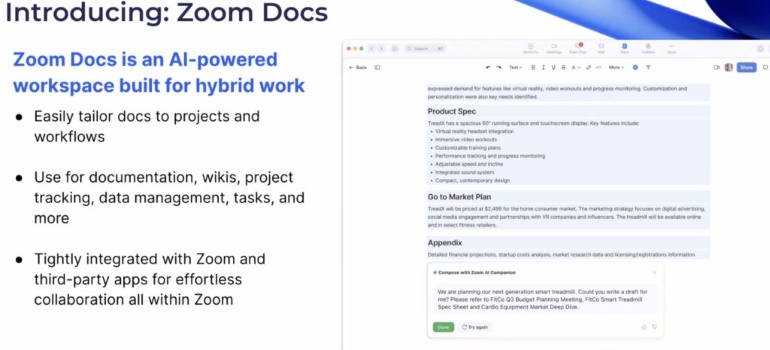Zoomtopia 2023 is the event of the year for document collaboration. Learn how Zoom is redefining the way we work together and collaborate on documents.
Collaboration vendor Zoom is holding its annual user event, Zoomtopia, in San Jose this week. While the company made many announcements, the highlight of CEO Eric Yuan’s keynote was the introduction of Zoom Docs, which puts Microsoft Word and Google Docs in the crosshairs.
This follows the introduction of Zoom Mail and Calendar earlier this year. The combination of Unified Communication, Contact Center, Email / Calendar, and Docs gives Zoom the broadest, fully integrated collaboration suite in the industry. While Microsoft and Google have the same components, they lack the tight integration provided by Zoom.
Zoom is rethinking document collaboration
During a pre-brief with analysts, Zoom Head of Products for Meetings, Rooms, and Workspaces, Jeff Smith, clarified that this isn’t your father’s document application when he discussed re-imagining documents.
He stated that traditional docs apps are meant to replicate paper, and the output was meant to be printed. In a world that is increasingly paperless, how we think about documents should also change.
Smith stated emphatically: “Zoom Docs marks the end of 8 ½ x 11” and called it “a next-generation way of collaborating.”
In some ways, the name Zoom Docs is a bit of a misnomer as the company delivers a workspace for people to collaborate through a document interface. While the application handles the traditional document experience, it enhances it with the following capabilities.
- Customizable documents. Workers can use content blocks to pull information into customizable layouts and workflows. Table blocks can organize data, manage projects, track tasks, and manage schedules through columns, filters, and groups.
- Easy delegation. With Zoom Docs, users can bring their team together to get more work done faster between meetings. Users can use “@” mentions of colleagues in the document to keep them in the loop, create a discussion, add comments and threads, and assign tasks to keep everyone on track.
- Combine knowledge with wikis and shared folders. Workers can create wikis to link pages and embed them in a visual tree, enabling teams to see how information is connected instantly. Pages can be grouped better to organize docs for a more complete knowledge source.
- Flexible working. Users can work directly in Zoom or Docs. The Zoom integration allows users to create, edit, and search Zoom Docs while in a Meeting or in a Team Chat. This can significantly cut down on the “toggle tax” we experience today that contributes to users spending about 40% of their time managing work.

AI Companion boosts Zoom Docs value
Another benefit of the integration with the Zoom suite is the use of AI Companion within Zoom Docs. Workers can jump-start document creation by asking the AI engine to populate content. Alternatively, AI Companion could summarize content to create an executive overview or get caught up.
At Zoomtopia, Zoom also announced its global, unified search capabilities that enable workers to find information anywhere in the Zoom platform, including some third-party applications. I’ve experienced the frustration of remembering I received a document from someone but could not remember if they sent it through Zoom Chat or in an e-mail. This causes me to search both until I find it. The unified search feature allows workers to search across Zoom, streamlining that process.
Artificial intelligence was a key theme at Zoomtopia as the company reiterated its federated, responsible, and empowering approach. Contrary to many news articles, Zoom will not use customer data without permission. This includes customer audio video, chat, screen sharing, attachments, or any other information inside Zoom.
Zoom is democratizing AI
Zoom has set the price point for AI Companion at free with any paid license. During the analyst briefing, Randy Maestre, Head of Zoom AI, Ecosystem, and Industry Product Marketing, stated, “We believe AI should be affordable and accessible to everyone, so we have included AI Companion at no additional cost for customers.”
This can save companies a significant amount of money compared to the $30 per month and up for similar features from Google and Microsoft.
New AI Companion features announced at Zoomtopia include real-time feedback and coaching, AI for Zoom Phone, and the ability to handle complex tasks across Zoom and third-party applications. This complements the existing features of whiteboard content generation, smart recordings, in-meeting queries, meeting summaries, chat thread summaries, and composing emails and chats.
Most of the collaboration vendors have chosen a co-existence strategy when it comes to Microsoft Teams. Not so for Zoom, as the introduction of Zoom Docs, which follows the rollout of Mail and Calendar, is clearly a shot across Microsoft’s bow.
Bottom Line: Platform Integration
Will Zoom see success? Only time will tell, but what Zoom has on its side is a product that is much less complicated and has better platform integration than the bloated Microsoft Office experience.
Also, workers tend to love Zoom and often push the IT organization into bringing it in as an alternative to Teams. While the introduction of Zoom Docs will capture the headlines, it’s the use of AI and global search that creates tangible user value.
